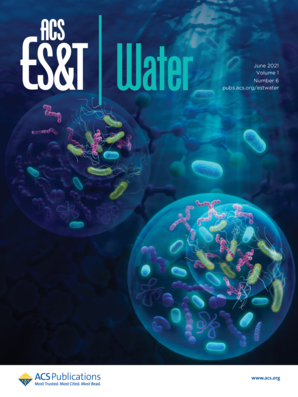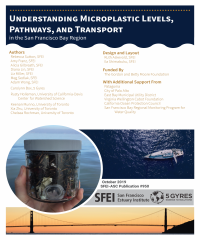Library
Our library features many hundreds of entries.
To search among them, click "Search" below to pull down options, including filtering by document type, author, year, and keyword.
Find these options under "Show only items where." Or you can also sort by author, title, type, and year clicking the headings below.
2022. An Urban Forest Master Plan for East Palo Alto. SFEI Contribution No. 1071. San Francisco Estuary Institute: Richmond, CA.
2021. Urban Stormwater Runoff: A Major Pathway for Anthropogenic Particles, Black Rubbery Fragments, and Other Types of Microplastics to Urban Receiving Waters. Environmental Science and Technology Water . SFEI Contribution No. 1040.
 Stormwater runoff has been suggested to be a significant pathway of microplastics to aquatic habitats; yet, few studies have quantified microplastics in stormwater. Here, we quantify and characterize urban stormwater runoff from 12 watersheds surrounding San Francisco Bay for anthropogenic debris, including microplastics. Depth-integrated samples were collected during wet weather events. All stormwater runoff contained anthropogenic microparticles, including microplastics, with concentrations ranging from 1.1 to 24.6 particles/L. These concentrations are much higher than those in wastewater treatment plant effluent, suggesting urban stormwater runoff is a major source of anthropogenic debris, including microplastics, to aquatic habitats. Fibers and black rubbery fragments (potentially tire and road wear particles) were the most frequently occurring morphologies, comprising ∼85% of all particles across all samples. This suggests that mitigation strategies for stormwater should be prioritized. As a case study, we sampled stormwater from the inlet and outlet of a rain garden during three storm events to measure how effectively rain gardens capture microplastics and prevent it from contaminating aquatic ecosystems. We found that the rain garden successfully removed 96% of anthropogenic debris on average and 100% of black rubbery fragments, suggesting rain gardens should be further explored as a mitigation strategy for microplastic pollution.
Stormwater runoff has been suggested to be a significant pathway of microplastics to aquatic habitats; yet, few studies have quantified microplastics in stormwater. Here, we quantify and characterize urban stormwater runoff from 12 watersheds surrounding San Francisco Bay for anthropogenic debris, including microplastics. Depth-integrated samples were collected during wet weather events. All stormwater runoff contained anthropogenic microparticles, including microplastics, with concentrations ranging from 1.1 to 24.6 particles/L. These concentrations are much higher than those in wastewater treatment plant effluent, suggesting urban stormwater runoff is a major source of anthropogenic debris, including microplastics, to aquatic habitats. Fibers and black rubbery fragments (potentially tire and road wear particles) were the most frequently occurring morphologies, comprising ∼85% of all particles across all samples. This suggests that mitigation strategies for stormwater should be prioritized. As a case study, we sampled stormwater from the inlet and outlet of a rain garden during three storm events to measure how effectively rain gardens capture microplastics and prevent it from contaminating aquatic ecosystems. We found that the rain garden successfully removed 96% of anthropogenic debris on average and 100% of black rubbery fragments, suggesting rain gardens should be further explored as a mitigation strategy for microplastic pollution.
2019. Understanding Microplastic Levels, Pathways, and Transport in the San Francisco Bay Region. SFEI Contribution No. 950. San Francisco Estuary Institute: Richmond, CA.
 Microplastics (particles less than 5 mm) are ubiquitous and persistent pollutants in the ocean and a pervasive and preventable threat to the health of marine ecosystems. Microplastics come in a wide variety of shapes, sizes, and plastic types, each with unique physical and chemical properties and toxicological impacts. Understanding the magnitude of the microplastics problem and determining the highest priorities for mitigation require accurate measures of microplastic occurrence in the environment and identification of likely sources.
Microplastics (particles less than 5 mm) are ubiquitous and persistent pollutants in the ocean and a pervasive and preventable threat to the health of marine ecosystems. Microplastics come in a wide variety of shapes, sizes, and plastic types, each with unique physical and chemical properties and toxicological impacts. Understanding the magnitude of the microplastics problem and determining the highest priorities for mitigation require accurate measures of microplastic occurrence in the environment and identification of likely sources.
To develop critical baseline data and inform solutions, the San Francisco Estuary Institute and the 5 Gyres Institute have completed the first comprehensive regional study of microplastic pollution in a major estuary. This project supported multiple scientific components to develop improved knowledge about and characterization of microparticles and microplastics in San Francisco Bay and adjacent National Marine Sanctuaries, with the following objectives:
- Contribute to the development and standardization of sample collection and analysis methodology for microplastic transportation research.
- Determine a baseline for future monitoring of microplastics in San Francisco Bay surface water, sediment, and fish, and in ocean waters outside the Golden Gate.
- Characterize pathways by which microplastics enter the Bay, including urban stormwater and treated wastewater effluent.
- Investigate the contribution of Bay microplastics to the adjacent National Marine Sanctuaries through computer simulations.
- Communicate findings to regional stakeholders and the general public through meetings and educational materials.
- Facilitate evaluation of policy options for San Francisco Bay, with recommendations on source reduction.
This document presents the findings of this three-year project. A companion document, “San Francisco Bay Microplastics Project: Science-Supported Solutions and Policy Recommendations,” has been developed by 5 Gyres using the findings of this study (Box and Cummins, 2019).
2019. Urban Ecological Planning Guide for Santa Clara Valley. SFEI Contribution No. 941. San Francisco Estuary Institute: Richmond, CA.
This document provides some of the scientific foundation needed to guide planning for urban biodiversity in the Santa Clara Valley region, grounded in an understanding of landscape history, urban ecology and local setting. It can be used to envision the ecological potential for individual urban greening projects, and to guide their siting, design and implementation. It also can be used to guide coordination of projects across the landscape, with the cooperation of a group of stakeholders (such as multiple agencies, cities and counties). Users of this report may include a wide range of entities, such as local nonprofits, public agencies, city planners, and applicants to the Open Space Authority’s Urban Open Space Grant Program.
This document provides some of the scientific foundation needed to guide planning for urban biodiversity in the Santa Clara Valley region, grounded in an understanding of landscape history, urban ecology and local setting. It can be used to envision the ecological potential for individual urban greening projects, and to guide their siting, design and implementation. It also can be used to guide coordination of projects across the landscape, with the cooperation of a group of stakeholders (such as multiple agencies, cities and counties). Users of this report may include a wide range of entities, such as local nonprofits, public agencies, city planners, and applicants to the Open Space Authority’s Urban Open Space Grant Program.
2016. Upper Pajaro River Watershed Condition Assessment 2015. Technical memorandum prepared for the Santa Clara Valley Water District - Priority D5 Project. SFEI Contribution No. 810. San Francisco Estuary Institute: Richmond, CA. p 60.
In 2015 The Santa Clara Valley Water District and it's consultants conducted a watershed wide survey to characterize the distribution and abundance of the aquatic resources within the upper Pajaro River watershed wtihin Santa Clara County, CA based on available GIS datasets, and to assess the overall ecological condition of streams within the watershed based on a statistically based random sample design and the California Rapid Assessment Method for streams (CRAM).
2012. Upper Penitencia Creek Historical Ecology Assessment. SFEI Contribution No. 664. SFEI: Richmond, CA.
2008. The UC Davis Biosentinel Mercury Program: Using Small Fish to Monitor Fine-scale Patterns of Methylmercury Contamination in the Watershed. SFEI Contribution No. 552. San Francisco Estuary Institute.
2000. Unmixing polychlorinated biphenyl source fingerprints in surface waters of San Francisco Bay. Environmental Science and Technology 34, 552-559 . SFEI Contribution No. 270.
1994. Uptake of lipophilic organic Cu, Cd, and Pb complexes in the coastal diatom, Thalassiosira Weissflogii. Environmental Science and Technology 28, 1781-1790 . SFEI Contribution No. 179.

